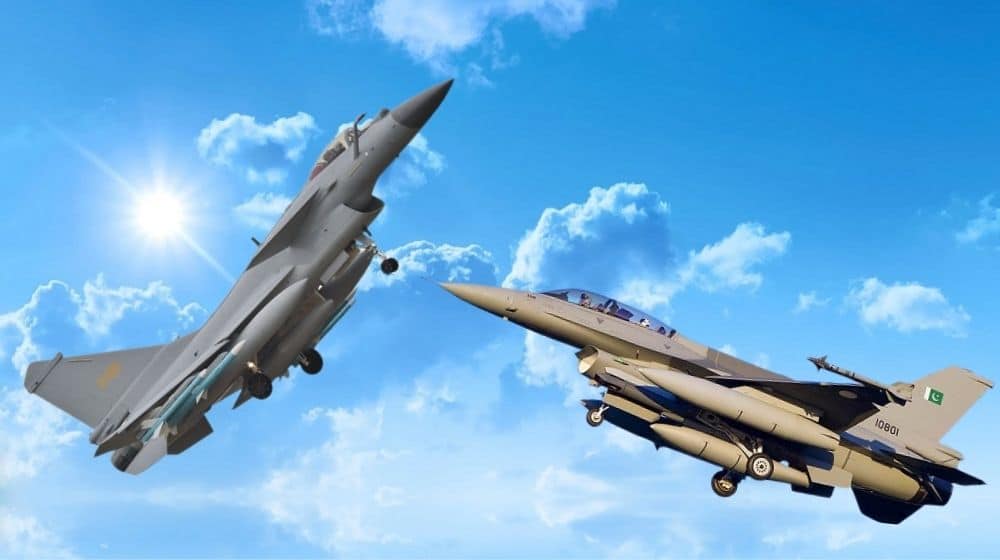With just days remaining in the National Day Parade, the excitement among the public to witness the fighter jets performing aerial maneuvers above the Parade Ground is at an all-time high.
Talking of fighter jets, one name that immediately comes to mind is F-16. In 1983, Pakistan Air Force (PAF) acquired the first batch of F-16 jets from the US. The first Pakistani F-16 was flown by Squadron Leader Shahid Javed at PAF Base Sargodha which is now known as PAF Base Mushaf.
The F-16 Fighting Falcon is a single-engine multirole fighter jet. It was initially designed as an air superiority day fighter aircraft. It later evolved into a formidable all-weather multirole jet.
Despite manufacturing the JF-17 fighters in collaboration with China in February 2010, F-16s still remain relevant in the national aerial defense and they will continue to do so in coming years.
Before inducting the JF-17s, PAF also used A-5C, J-7, Mirage III, and Mirage V jets to guard the aerial boundaries of Pakistan for decades.
F-16s, JF-17s, and the recently inducted J10-Cs now constitute the primary aerial defense of the country. PAF inducted the J-10C fighter jets after acquiring them from China in just eight months rather than years that defense manufacturers normally take to deliver a fighter jet such as the J-10C.
The J-10C fighter jet is a multi-role combat aircraft capable of all-weather operations. It is primarily designed for air-to-air combat but it can perform strike missions as well.
In the last article of this special series, we compared JF-17 and J-10C. In the latest edition, we are going to compare F-16 and J-10C. So without further ado, let’s dive straight into it.
Basic Description
While the F-16 is lighter than J-10C and belongs to a previous generation, both have a similar engine and are designed for a similar role.
| Attributes | F-16 | J-10C |
| Weight | Light-weight | Medium-weight |
| Engine | Single-engine | Single-engine |
| Generation | 4th generation | 4.5th generation |
| Role | Multi-role | Multi-role |
General Characteristics
The length of F-16 is shorter than J-10C while its fuel capacity is also significantly lower than J-10C. Both jets have almost similar remaining features.
| Features | F-16 | J-10C |
| Crew | 2 | 1 |
| Length | 49 feet 5 inches | 55 feet 2 inches |
| Wingspan | 32 feet 8 inches | 32 feet 2 inches |
| Height | 16 feet | 18 feet 8 inches |
| Wing area | 300 sq. ft. | 400 sq. ft. |
| Empty weight | 8,936 kg | 9,750 kg |
| Max takeoff weight | 16,875 kg | 19,277 kg |
| Fuel capacity | 8,618 kg | 7,380 kg |
| Powerplant | 1 × Pratt & Whitney F100-PW-229 afterburning turbofan, 79 kN thrust dry, 131.5 kN with afterburner | 1 x WS-10B afterburning turbofan engines, 89.17 kN thrust dry, 142 kN with afterburner |
Performance
F-16 has a superior maximum speed and ferry range compared to the J-10. The rest of the characteristics are almost identical.
| Characteristics | F-16 | J-10C |
| Maximum Speed | Mach 2.05 | Mach 1.8 |
| Ferry Range | 4,217 km | 2,950 km |
| Service ceiling | 58,000 feet | 56,000 feet |
| G limits | +9 | +9/-3 |
| Thrust/weight | 1.09 | 1.10 |
Armament
Both jets are loaded with a wide range of guns, rockets, air-to-air missiles, and air-to-surface missiles.
| Weapons | F-16 | J-10C |
| Guns | 1 × 20 mm (0.787 in) M61A1 Vulcan 6-barrel rotary cannon, 511 rounds | 1× Gryazev-Shipunov GSh-23 |
| Hardpoints | 2 × wing-tip air-to-air missile launch rails, 6 × under-wing, and 3 × under-fuselage pylon (2 of 3 for sensors) stations with a capacity of up to 7,700 kg of stores | 11 (6× under-wing, 2× under-intake and 3× under-fuselage) with a capacity of 5600 kg of external fuel and ordnance |
| Rockets | LAU-61/LAU-68 rocket pods (each with 19/7 × Hydra 70 mm/APKWS rockets, respectively
LAU-5003 rocket pods (each with 19 × CRV7 70 mm rockets) LAU-10 rocket pods (each with 4 × Zuni 127 mm rockets) |
90 mm unguided rocket |
| Air-to-air Missiles | AIM-9 Sidewinder
AIM-120 AMRAAM IRIS-T Python-4 Python-5 |
PL-8
PL-10 PL-12 PL-15 |
| Air-to-surface Missles | AGM-65 Maverick
AGM-88 HARM AGM-158 Joint Air-to-Surface Standoff Missile (JASSM) AGM-154 Joint Standoff Weapon (JSOW) |
KD-88
YJ-91 |
| Anti-ship Missiles | AGM-84 Harpoon
AGM-119 Penguin |
– |
| Bombs | CBU-87 Combined Effects Munition
CBU-89 Gator mine CBU-97 Sensor Fuzed Weapon Mark 84 general-purpose bombs Mark 83 GP bombs Mark 82 GP bombs GBU-39 Small Diameter Bomb (SDB) GBU-10 Paveway II GBU-12 Paveway II GBU-24 Paveway III GBU-27 Paveway III Joint Direct Attack Munition (JDAM) series Wind Corrected Munitions Dispenser (WCMD) B61 nuclear bomb B83 nuclear bomb |
250 kg and 500 kg Pre-fragmented bomb
LT-2 LS-6 GB3 GB2A GB3A FT-1
|
Avionics
| F-16 | J-10C |
| AN/APG-68 radar | Type 1473H pulse-doppler fire control radar |
| MIL-STD-1553 bus | K/JDC01A targeting pod |
| Type Hongguang-I infra-red search and track pod | |
| CM-802AKG targeting pod for KD-88 and YJ-91 | |
| KG600 electronic countermeasure pod | |
| Blue Sky navigation/attack pod |
Variants
| F-16 | J-10C |
| F-16A | J-10A |
| F-16B | J-10AH |
| F-16C | J-10S |
| F-16D | J-10SH |
| F-16E | J-10B |
| F-16F | J-10B TVC Demonstrator |
| F-16IN | J-10C |
| F-16IQ | J-10CE |
| F-16N | |
| F-16V | |
| QF-16 |
Operators
| F-16 | J-10C |
| US | China |
| Pakistan | Pakistan |
| Bahrain | |
| Chile | |
| Denmark | |
| Egypt | |
| Greece | |
| Indonesia | |
| Iraq | |
| Israel | |
| Jordan | |
| Morocco | |
| Netherlands | |
| Oman | |
| Poland | |
| Portugal | |
| Romania | |
| Singapore | |
| South Korea | |
| Taiwan | |
| Thailand | |
| Turkey | |
| UAE | |
| Venezuela |
Note that Pakistan is the first country that has acquired the J10-C from China and most details of the export variant of the Chinese fighter jet are yet to be revealed officially.






















Lol..please do us a favour and stop posting about stuff you don’t know. It’s all wrong info. F-16 is neither a light weight nor a 4th gen. Its both medium weight and 4.5 gen in block 70/72.
Pakistan Does not have block 70/72 😒.
Evolving airforce